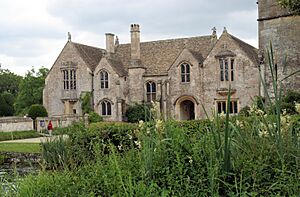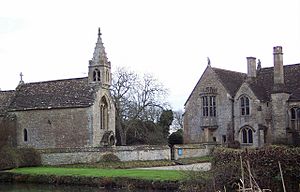Great Chalfield Manor facts for kids
Great Chalfield Manor is a beautiful old country house in England. It's located near the town of Bradford on Avon in Wiltshire. This special house is known for its amazing history and unique design.
Contents
A Look Back at Great Chalfield's History
Many people think Great Chalfield Manor is one of the best examples of a late medieval English manor house. It was built a long time ago, between 1465 and 1480.
Who Built This Amazing House?
The house was built for a man named Thomas Tropenell. He wasn't born into a rich family, but he became wealthy as a cloth merchant. He built the manor on the spot where an older, fortified house once stood. You can still see parts of the old walls and towers today.
What Makes the Manor Special?
The house has a main hall that gets light from both sides. It's surrounded by two wings with pointed roofs. These wings look very balanced from the outside, which was unusual for houses built at that time. There are also special bay windows, called oriel windows, and small porches.
The nearby church, which Thomas Tropenell also rebuilt, faces the house's courtyard. This shows how closely connected the church and the manor were back then. Part of a moat (a ditch filled with water) still remains around the house.
Who Lived Here After Thomas Tropenell?
The house stayed in the Tropenell family for a while. In 1550, it passed to the Eyre family when Ann Tropenell married John Eyre. It stayed with the Eyres for three generations.
Later, in 1631, Sir John Eyre sold the house to Sir Richard Gurney, 1st Baronet. He was the Lord Mayor of London. Over the years, the manor was owned by several other families, including the Hanhams, the Halls, and the Pierreponts.
Changes Over Time
In the 1800s, the house was changed quite a bit. Some of its original look was lost. The great hall, for example, was used as a farmhouse and its fancy ceiling was removed. Only one of the original decorative pieces from the ceiling is left.
The Unique Gardens
Outside the manor, there's a lovely garden. You can find four special "tree houses" there. These are groups of four yew trees that have grown together. They've been carefully shaped and hollowed out inside, so you can actually walk through them!
Great Chalfield in the 20th Century and Today
In the early 1900s, George Fuller bought the house and its gardens. His son, Major Robert Fuller, then worked to restore the manor between 1905 and 1911. He made sure the house looked its best again. A famous artist named Alfred Parsons helped design the beautiful gardens.
Visiting the Manor Today
In 1943, Robert Fuller gave the house and nine acres of land to the National Trust. This means it's now open for the public to visit. Robert Floyd, who is Robert Fuller's grandson, and his family live at the manor. They help manage the property for the National Trust. If you visit, you can take a guided tour of the house.
Great Chalfield Manor is a very important historical building. It's listed as a Grade I listed building. This means it's considered to be of exceptional interest. A special old book, called the Tropenell Cartulary, which belonged to Thomas Tropenell, is still kept there. The old barn near the house is also Grade I listed, and the gardens are Grade II listed.
All Saints' Church
Right next to Great Chalfield Manor is All Saints' Church. It's a small church that dates back to the 1300s. This church is the local parish church for Great Chalfield.
Church History and Features
The church was first mentioned in 1316. Thomas Tropenell rebuilt most of the church around 1480. You can still see parts from that time, like the south chapel and the small bell tower. The roof of the main part of the church, called the nave, is also original.
Later, in 1775, Robert Neale made some improvements. He added a family chapel, which is now used as a vestry. Many of the windows were added in the 1800s, and more restoration work happened in 1914. The font, where baptisms take place, is from the 1200s, and the pulpit is from the 1600s.
The church records go all the way back to 1605. Like the manor, All Saints' Church is also a Grade I listed building.
Great Chalfield on Screen
Great Chalfield Manor and its grounds have been used as a filming location for many movies and TV shows. Its historic look makes it perfect for period dramas.
Some of the productions filmed here include:
- Wives and Daughters (1999)
- Persuasion (2007)
- The Other Boleyn Girl (2008)
- Tess of the d'Urbervilles (2008)
- Wolf Hall (2014)
- Poldark (2015)
- The White Princess (2017)
More recently, scenes for Wolf Hall: The Mirror and the Light (2024) were filmed inside the study and the Great Hall. Outdoor scenes were also shot in the beautiful Arts and Crafts gardens.




